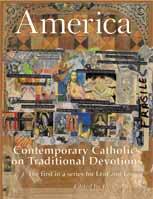I have never felt the attachment I should to the daily prayers of the church. Their depth and meaning have rubbed off with repetition, to the point where I am stirred by them only when I say them in a foreign language. Words are tricky that way. It is very different with my favorite ritual, which is carried out in silence: the taking of holy water at the door of the church.
There is, I know, nothing particularly Catholic or even Christian about this action: the taking of water to sanctify and purify is a ritual almost as old as mankind. Britain and Ireland are dotted with springs and wells that have been sacred successively to Celts, Romans, medieval hermits and modern schoolchildren. Some are still overshadowed by their holy treesoaks, hawthorn, ash and yewon which visitors hang little scraps of cloth, or press coins into the bark in the hope of healing.
Such practices may be dismissed as pagan, but they do not seem so to me. Water and trees have a deep symbolism to Christians, too, as instruments of our salvation. That is why I have sometimes felt moved to make the Sign of the Cross in the middle of a wood or at the sight of a solitary tree, and why, coming on a spring rising by the side of the road or on a hillside, I almost always do so.
Holy-water stoups came very early to Christianity. Stoups of marble, glass and terra cotta have been found in the catacombs, and niches and urns for water occur in ancient cemeteries as well as churches. Many holy-water fonts were simple, sometimes no more than seashells; others were grand affairs, proper fountains for ablutions of both hands and feet. A visitor to St. Sophia in sixth-century Constantinople described water gurgling noisily into the air from a bronze pipe with a force that banishes all evils. Medieval stoups were sometimes segregated, with nobles dipping their hands in one and the unwashed in another.
We no longer use the font to wash, but to take water upon entering a church is still a vital act. It recognizes the demarcation between secular and sacred space: we have turned out of the noisy street into God’s quiet place, and we acknowledge it. We also remember our baptism, our entry by water into the larger church; but this time we perform the sacrament ourselves, in miniature. And we purify ourselves for spiritual action, even if it is only the action of sitting in silence for a while or looking at the stained glass. I daresay there are prayers to accompany the action, but I myself never say any. The action, in fact, empties my mind of the words that constantly teem thereempties it long enough, perhaps, to prepare myself to be silent and listen.
I feel cheated if, on entering a church, the stoup is dry. It happens disappointingly often: dust on the fingertips, or a tideline of green mold where life and spirit should be. Whenever this occurs, I find it hard to settle. My prayer itself seems dry, as if water is the medium that makes it work. Our local priest once explained that he could not fill the stoup because he had no water that had been blessed. But I feel that all water is blessed, even six-times-recycled London water from the tap, and I fetched some from the sanctuary to make the point. The action of making the Sign of the Cross with water is wonderfully strengthening and restoring, no matter how humble its origins; just as a glass of this water, if you are truly thirsty, refreshes the parched body as well as any other.
It also seems important that I do the action for myself. I have always felt a little doubtful about the ritual of asperging. Most priests I know do it with joyful, almost childlike, abandon, but the water falls too haphazardly, as if never meant for me in the first place. There is more benediction in walking through a shower of rain: rain falling softly and evenly on both the just and the unjust, the best metaphor for the mercy of God. Rather than accept the dubious blessing chance throws me, I must deliberately and consciously take up the drops myself. It is a sanctification that links me to every man and woman who has ever felt God through water, and thanked him, a line of wordless prayer that goes back almost to the dawn of humankind itself.









Thank you for posting. You style is clear and fun. Shall be reading your books forthwith.
Have you any idea or opinion on the prohibition/ acceptance of holy water in the Jewish faith? I have read that no matter its origin, the meaning is the same: purification, ward off impurities and to receive blessings.
Sincerely,
Mary Q